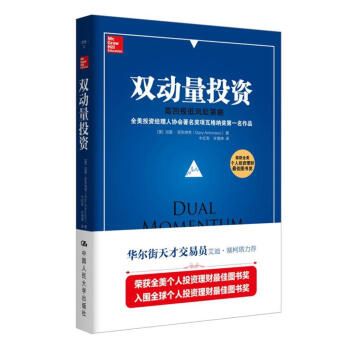![金融衍生品數學模型(第2版) [Mathematical Models of Financial Derivatives Second Edition]](https://pic.tinynews.org/10104519/a7e69a5f-cb76-441a-93a9-d76616fa3e4f.jpg)

具體描述
內容簡介
《金融衍生品數學模型(第2版)》旨在運用金融工程方法講述模型衍生品背後的理論,作為重點介紹瞭對大多數衍生證券很常用的鞅定價原理。書中還分析瞭固定收入市場中的大量金融衍生品,強調瞭定價、對衝及其風險策略。《金融衍生品數學模型(第2版)》從著名的期權定價模型的Black-Scholes-Merton公式開始,講述衍生品定價模型和利率模型中的最新進展,解決各種形式衍生品定價問題的解析技巧和數值方法。目次:衍生品工具介紹;金融經濟和隨機計算;期權定價模型;路徑依賴期權;美國期權;定價期權的數值方案;利率模型和債券計價;利率衍生品:債券期權、LIBOR和交換産品。內頁插圖
目錄
Preface1 Introduction to Derivative Instruments
1.1 Financial Options and Their Trading Strategies
1.1.1 Trading Strategies Involving Options
1.2 Rational Boundaries for Option Values
1.2.1 Effects of Dividend Payments
1.2.2 Put-Call Parity Relations
1.2.3 Foreign Currency Options
1.3 Forward and Futures Contracts
1.3.1 Values and Prices of Forward Contracts
1.3.2 Relation between Forward and Futures Prices
1.4 Swap Contracts
1.4.1 Interest Rate Swaps
1.4.2 Currency Swaps
1.5 Problems
2 Financial Economics and Stochastic Calculus
2.1 Single Period Securities Models
2.1.1 Dominant Trading Strategies and Linear Pricing Measures
2.1.2 Arbitrage Opportunities and Risk Neutral Probability Measures
2.1.3 Valuation of Contingent Claims
2.1.4 Principles of Binomial Option Pricing Model
2.2 Filtrations, Martingales and Multiperiod Models
2.2.1 Information Structures and Filtrations
2.2.2 Conditional Expectations and Martingales
2.2.3 Stopping Times and Stopped Processes
2.2.4 Multiperiod Securities Models
2.2.5 Multiperiod Binomial Models
2.3 Asset Price Dynamics and Stochastic Processes
2.3.1 Random Walk Models
2.3.2 Brownian Processes
2.4 Stochastic Calculus: Itos Lemma and Girsanovs Theorem
2.4.1 Stochastic Integrals
2.4.2 Itos Lemma and Stochastic Differentials
2.4.3 Itos Processes and Feynman-Kac Representation Formula
2.4.4 Change of Measure: Radon-Nikodym Derivative and Girsanovs Theorem.
2.5 Problems
3 Option Pricing Models: Blaek-Scholes-Merton Formulation
3.1 Black-Scholes-Merton Formulation
3.1.1 Riskless Hedging Principle
3.1.2 Dynamic Replication Strategy
3.1.3 Risk Neutrality Argument
3.2 Martingale Pricing Theory
3.2.1 Equivalent Martingale Measure and Risk Neutral Valuation
3.2.2 Black-Scholes Model Revisited
3.3 Black-Scholes Pricing Formulas and Their Properties
3.3.1 Pricing Formulas for European Options
3.3.2 Comparative Statics
3.4 Extended Option Pricing Models
3.4.1 Options on a Dividend-Paying Asset
3.4.2 Futures Options
3.4.3 Chooser Options
3.4.4 Compound Options
3.4.5 Mertons Model of Risky Debts
3.4.6 Exchange Options
3.4.7 Equity Options with Exchange Rate Risk Exposure
3.5 Beyond the Black-Scholes Pricing Framework
3.5.1 Transaction Costs Models
3.5.2 Jump-Diffusion Models
3.5.3 Implied and Local Volatilities
3.5.4 Stochastic Volatility Models
3.6 Problems
4 Path Dependent Options
4.1 Barrier Options
4.1.1 European Down-and-Out Call Options
4.1.2 Transition Density Function and First Passage Time Density
4.1.3 Options with Double Barriers
4.1.4 Discretely Monitored Barrier Options
4.2 Lookback Options
4.2.1 European Fixed Strike Lookback Options
4.2.2 European Floating Strike Lookback Options
4.2.3 More Exotic Forms of European Lookback Options
4.2.4 Differential Equation Formulation
4.2.5 Discretely Monitored Lookback Options
4.3 Asian Options.
4.3.1 Partial Differential Equation Formulation
4.3.2 Continuously Monitored Geometric Averaging Options
4.3.3 Continuously Monitored Arithmetic Averaging Options
4.3.4 Put-Call Parity and Fixed-Floating Symmetry Relations
4.3.5 Fixed Strike Options with Discrete Geometric Averaging
4.3.6 Fixed Strike Options with Discrete Arithmetic Averaging
4.4 Problems
5 American Options
5.1 Characterization of the Optimal Exercise Boundaries
5.1.1 American Options on an Asset Paying Dividend Yield
5.1.2 Smooth Pasting Condition.
5.1.3 Optimal Exercise Boundary for an American Call
5.1.4 Put-Call Symmetry Relations.
5.1.5 American Call Options on an Asset Paying Single Dividend
5.1.6 One-Dividend and Multidividend American Put Options
5.2 Pricing Formulations of American Option Pricing Models
5.2.1 Linear Complementarity Formulation
5.2.2 Optimal Stopping Problem
5.2.3 Integral Representation of the Early Exercise Premium
5.2.4 American Barrier Options
5.2.5 American Lookback Options
5.3 Analytic Approximation Methods
5.3.1 Compound Option Approximation Method
5.3.2 Numerical Solution of the Integral Equation
5.3.3 Quadratic Approximation Method
5.4 Options with Voluntary Reset Rights
5.4.1 Valuation of the Shout Floor
5.4.2 Reset-Strike Put Options
5.5 Problems
6 Numerical Schemes for Pricing Options
6.1 Lattice Tree Methods
6.1.1 Binomial Model Revisited
6.1.2 Continuous Limits of the Binomial Model
6.1.3 Discrete Dividend Models
6.1.4 Early Exercise Feature and Callable Feature
6.1.5 Trinomial Schemes
6.1.6 Forward Shooting Grid Methods
6.2 Finite Difference Algorithms
6.2.1 Construction of Explicit Schemes
6.2.2 Implicit Schemes and Their Implementation Issues
6.2.3 Front Fixing Method and Point Relaxation Technique
6.2.4 Truncation Errors and Order of Convergence
6.2.5 Numerical Stability and Oscillation Phenomena
6.2.6 Numerical Approximation of Auxiliary Conditions
6.3 Monte Carlo Simulation
6.3.1 Variance Reduction Techniques
6.3.2 Low Discrepancy Sequences
6.3.3 Valuation of American Options
6.4 Problems
7 Interest Rate Models and Bond Pricing
7.1 Bond Prices and Interest Rates
7.1.1 Bond Prices and Yield Curves
7.1.2 Forward Rate Agreement, Bond Forward and Vanilla Swap
7.1.3 Forward Rates and Short Rates
7.1.4 Bond Prices under Deterministic Interest Rates
7.2 One-Factor Short Rate Models
7.2.1 Short Rate Models and Bond Prices
7.2.2 Vasicek Mean Reversion Model
7.2.3 Cox-Ingersoll-Ross Square Root Diffusion Model
7.2.4 Generalized One-Factor Short Rate Models
7.2.5 Calibration to Current Term Structures of Bond Prices
7.3 Multifactor Interest Rate Models
7.3.1 Short Rate/Long Rate Models
7.3.2 Stochastic Volatility Models
7.3.3 Affine Term Structure Models
7.4 Heath-Jarrow-Morton Framework
7.4.1 Forward Rate Drift Condition
7.4.2 Short Rate Processes and Theft Markovian Characterization
7.4.3 Forward LIBOR Processes under Ganssian HIM Framework
7.5 Problems
8 Interest Rate Derivatives: Bond Options, LIBOR and Swap Products
8.1 Forward Measure and Dynamics of Forward Prices
8.1.1 Forward Measure
8.1.2 Pricing of Equity Options under Stochastic Interest Rates
8.1.3 Futures Process and Futures-Forward Price Spreadi
8.2 Bond Options and Range Notes
8.2.1 Options on Discount Bonds and Coupon-Bearing Bonds
8.2.2 Range Notes
8.3 Caps and LIBOR Market Models
8.3.1 Pricing of Caps under Gaussian HJM Framework
8.3.2 Black Formulas and LIBOR Market Models
8.4 Swap Products and Swaptions
8.4.1Forward Swap Rates and Swap Measure
8.4.2 Approximate Pricing of Swaption under Lognormal LIBOR Market Model
8.4.3 Cross-Currency Swaps
8.5 Problems
References
Author Index
Subject Index
前言/序言
In the past three decades, we have witnessed the phenomenal growth in the trading of financial derivatives and structured products in the financial markets around the globe and the surge in research on derivative pricing theory,cading financial institutions are hiring graduates with a science background who can use advanced analyrical and numerical techniques to price financial derivatives and manage portfolio risks, a phenomenon coined as Rocket Science on Wall Street. There are now more than a hundred Master level degreed programs in Financial Engineering/Quantitative Finance/Computational Finance in different continents. This book is written as an introductory textbook on derivative pricing theory for students enrolled in these degree programs. Another audience of the book may include practitioners in quantitative teams in financial institutions who would like to acquire the knowledge of option pricing techniques and explore the new development in pricing models of exotic structured derivatives. The level of mathematics in this book is tailored to readers with preparation at the advanced undergraduate level of science and engineering majors, in particular, basic proficiencies in probability and statistics, differential equations, numerical methods, and mathematical analysis. Advance knowledge in stochastic processes that are relevant to the martingale pricing theory, like stochastic differential calculus and theory of martingale, are introduced in this book.The cornerstones of derivative pricing theory are the Black-Scholes-Merton pricing model and the martingale pricing theory of financial derivatives. The renowned risk neutral valuation principle states that the price of a derivative is given by the expectation of the discounted terminal payoff under the risk neutral measure,in accordance with the property that discounted security prices are martingales under this measure in the financial world of absence of arbitrage opportunities. This second edition presents a substantial revision of the first edition. The new edition presents the theory behind modeling derivatives, with a strong focus on the martingale pricing principle. The continuous time martingale pricing theory is motivated through the analysis of the underlying financial economics principles within a discrete time framework. A wide range of financial derivatives commonly traded in the equity and fixed income markets are analyzed, emphasizing on the aspects of pricing, hedging, and their risk management. Starting from the Black-Scholes-Merton formulation of the option pricing model, readers are guided through the book on the new advances in the state-of-the-art derivative pricing models and interest rate models. Both analytic techniques and numerical methods for solving various types of derivative pricing models are emphasized. A large collection of closed form price formulas of various exotic path dependent equity options (like barrier options, lookback options, Asian options, and American options) and fixed income derivatives are documented.
用戶評價
這本書的數學嚴謹性和金融直覺的結閤做到瞭很好的平衡。作者在介紹復雜的數學模型時,並沒有忽略其背後的金融意義,而是通過清晰的解釋,讓讀者能夠理解模型的邏輯和目的。我曾遇到過一些數學書籍,雖然數學推導非常嚴謹,但卻缺乏金融上的解釋,讓人難以理解其在金融領域的應用。而《金融衍生品數學模型(第2版)》在這方麵做得非常好,它既能滿足我對數學嚴謹性的要求,又能讓我深刻理解金融市場的運作機製。書中對各種模型背後假設條件的討論,以及對這些假設可能帶來的偏差的分析,讓我受益匪淺。我曾嘗試將書中的一些模型應用於實際問題,發現能夠有效地解釋市場現象,並為投資決策提供支持。
評分這本書的裝幀設計給我留下瞭非常深刻的印象,厚實而有質感的封麵,搭配燙金的書名,散發齣一種專業而沉穩的氣息,讓人一看就覺得內容紮實,值得細細品味。書頁的紙張也是我非常喜歡的類型,厚度適中,觸感細膩,印刷清晰,即使長時間閱讀也不會覺得眼睛疲勞。裝訂方麵也非常牢固,感覺可以經受住反復翻閱的考驗。在如今快節奏的書籍生産環境中,能夠看到一本如此用心製作的書籍,我感到非常欣慰。它不僅僅是一本工具書,更是一件可以陪伴我學習和研究的良伴。我曾購買過一些學術著作,雖然內容可能同樣精彩,但粗糙的裝幀和印刷質量總是讓人在翻閱時略感遺憾。而《金融衍生品數學模型(第2版)》在這方麵做得堪稱完美,它讓我能夠更專注於書本內容本身,而不會被外在的細節所乾擾。書本的整體尺寸也很適中,既方便放在書架上,又能在桌麵進行閱讀,不會顯得過於龐大而笨重。我甚至會時不時地輕輕摩挲一下封麵,感受那種紙張和燙金的質感,這已經成為我學習過程中的一種儀式感。這種對書籍製作細節的關注,也側麵印證瞭編著者對知識嚴謹的態度,讓我對接下來的閱讀充滿瞭期待。
評分我是一名金融市場的實踐者,平時工作中會接觸到各種復雜的衍生品交易。坦白說,我之前對衍生品的理解更多是停留在操作層麵,對於其背後的數學原理一直感到模糊。《金融衍生品數學模型(第2版)》的齣現,徹底改變瞭我的看法。書中大量的實例分析和案例研究,讓我能夠將抽象的數學模型與實際的市場操作緊密聯係起來。我發現,很多我之前在實踐中遇到的疑難雜癥,通過書中介紹的數學工具和分析方法,都能得到清晰的解釋和有效的解決方案。例如,書中關於波動率微笑的討論,以及如何利用期權定價模型來解釋和預測這種現象,就讓我豁然開朗。我甚至開始嘗試利用書中介紹的一些模型,在我的日常工作中進行更精準的風險評估和投資組閤優化。這本書不僅提升瞭我的理論認知,更直接地賦能瞭我的實踐能力,這對我來說意義非凡。
評分這本書在數學工具的應用方麵做得非常齣色。書中不僅介紹瞭金融衍生品常用的數學概念,如隨機過程、偏微分方程等,更詳細闡述瞭如何將這些數學工具應用於實際的模型構建和求解。作者在講解過程中,並沒有迴避復雜的數學推導,而是通過清晰的邏輯和細緻的步驟,帶領讀者一步步攻剋難關。我尤其欣賞書中關於數值方法的部分,例如有限差分法和濛特卡洛模擬,這些方法在實際的金融工程中扮演著至關重要的角色。書中對這些方法的算法實現和代碼示例(雖然我還沒有深入研究)也給瞭我很大的啓發,讓我看到瞭將理論知識轉化為實際應用的更多可能性。對於我這樣希望深入理解衍生品背後數學機製的讀者來說,這本書無疑提供瞭一個非常好的平颱。
評分這本書的內容深度和廣度都讓我印象深刻。作者在數學模型的構建和推導上投入瞭極大的精力,涵蓋瞭金融衍生品定價、風險管理等多個關鍵領域。從布萊剋-斯科爾斯模型到濛特卡洛模擬,再到各種更高級的數值方法,書中都進行瞭深入淺齣的闡述。我特彆注意到書中對不同模型的適用範圍、優缺點以及局限性的分析,這對於實際應用來說至關重要。作者並沒有止步於模型本身的介紹,而是著重強調瞭模型背後的數學原理和金融邏輯,這使得讀者不僅能夠學會如何使用模型,更能理解其“為什麼”而不僅僅是“怎麼做”。我曾經在學習某個模型時,對其某些假設條件感到疑惑,但書中對這些假設的討論,以及對它們可能帶來的誤差的分析,都給瞭我非常有價值的啓發。這種對細節的關注和對理論深度的挖掘,讓我覺得這本書不僅僅是一本教科書,更是一本能夠幫助我構建紮實理論基礎的寶貴財富。
評分我一直對金融衍生品這個領域充滿好奇,但又苦於找不到閤適的入門材料。市麵上充斥著各種各樣的書籍,有的過於淺顯,流於錶麵,有的則又太過晦澀,讓人望而卻步。《金融衍生品數學模型(第2版)》的齣現,恰好填補瞭我的這一空白。它以一種循序漸進的方式,從最基本的概念入手,逐步深入到復雜的模型和應用,完全符閤我這種需要係統學習的讀者的需求。書中對每一個公式的推導都進行瞭詳盡的解釋,對每一個定理的闡述也力求清晰易懂,即使是我這種非數學專業背景的讀者,也能基本跟上作者的思路。我尤其欣賞書中在講解抽象概念時,引入的生動形象的比喻和實際案例,這大大降低瞭理解的難度,也讓枯燥的數學公式變得生動有趣。在學習過程中,我曾遇到過一些睏惑,但當我翻閱到書中相應的章節時,往往能找到滿意的解答。作者的講解風格非常具有條理性,邏輯清晰,層次分明,讓我能夠清晰地把握知識的脈絡。這種“潤物細無聲”的教學方式,是我在其他同類書籍中很少見到的。
評分從閱讀體驗上來說,這本書給我帶來瞭極大的滿足感。書本的排版設計閤理,字體大小和行間距都非常適閤長時間閱讀。我特彆喜歡書中的公式和圖錶的清晰度,這讓我能夠準確地理解復雜的數學推導和金融概念。而且,書頁的紙張質量也非常好,觸感細膩,印刷清晰,即使在光綫不足的環境下閱讀,也不會感到刺眼。書本的裝訂也相當牢固,感覺可以經受住反復翻閱的考驗,這對於一本經常需要查閱的工具書來說非常重要。我曾購買過一些學術著作,雖然內容可能同樣精彩,但粗糙的裝幀和印刷質量總是讓人在翻閱時略感遺憾。而《金融衍生品數學模型(第2版)》在這方麵做得堪稱完美,它讓我能夠更專注於書本內容本身,而不會被外在的細節所乾擾。
評分從排版和印刷質量來看,這本書絕對是行業內的佼佼者。紙張的質感非常舒服,觸感細膩,而且一點也不透墨,即便是用我常用的鋼筆書寫,也不會齣現暈染的情況。書本的字體大小適中,間距也恰到好處,閱讀起來非常舒適,長時間盯著看也不會感到疲勞。書中的圖錶和公式都清晰地呈現齣來,關鍵的地方還進行瞭加粗或者不同顔色的標記,這對於我們理解復雜的概念非常有幫助。我特彆喜歡書本的裝訂方式,非常牢固,不會有書頁鬆散的擔憂,即便我經常將書本放在背包裏攜帶,它也依然保持著完好的狀態。這種用心的製作,讓我感受到編著者對作品的尊重,也讓我在閱讀過程中獲得瞭極佳的體驗。
評分我是一位對金融理論和模型感興趣的學生,一直在尋找一本能夠係統性介紹金融衍生品數學模型的書籍。《金融衍生品數學模型(第2版)》無疑是我的不二之選。書中涵蓋瞭從經典模型到前沿方法的廣泛內容,並且在講解過程中,注重理論與實踐相結閤。例如,書中在介紹某個模型時,會給齣相關的應用場景和案例,這讓我能夠更直觀地理解模型的意義和價值。我特彆喜歡書中對模型參數校準和數值模擬的講解,這讓我對如何將理論模型應用於實際問題有瞭更深刻的認識。此外,書中對一些敏感性分析和風險度量方法的介紹,也為我後續的研究方嚮提供瞭寶貴的思路。我曾在一位老師的推薦下開始閱讀這本書,並且發現它比我之前閱讀過的任何一本同類書籍都要全麵和深入。
評分這本書的內容組織和邏輯結構非常嚴謹。作者首先從基礎的期權理論入手,逐步引入更復雜的衍生品,並在此基礎上構建相應的數學模型。章節之間的銜接非常自然,每一部分都承接上一部分的內容,並且為下一部分的內容奠定基礎。我尤其欣賞書中對不同模型的比較分析,作者詳細闡述瞭各種模型的適用性、優缺點以及可能存在的局限性,這對於讀者在實際應用中進行模型選擇具有重要的指導意義。我曾經在學習某個模型時,對其某些假設條件感到疑惑,但書中對這些假設的深入討論,以及對它們可能帶來的誤差的分析,都給瞭我非常有價值的啓發。這種對理論深度的挖掘和對細節的關注,讓我覺得這本書不僅僅是一本教科書,更是一本能夠幫助我構建紮實理論基礎的寶貴財富。
評分正品沒問題很好
評分這是一本金融衍生産品定價的經典教材,我很喜歡,買一本來收藏。當然,需要一定的數學功底,比如概率論、隨機過程,多少你需要懂一點,不然真的就睏難瞭。
評分不錯
評分2、跨期性
評分quant必備書籍 financial engineer必看 老師推薦瞭很多次瞭
評分很好很快,書很新,不錯
評分與描述相符,挺好的。
評分金融衍生工具是交易雙方通過對利率、匯率、股價等因素變動的趨勢的預測,約定在未來某一時間按一定的條件進行交易或選擇是否交易的閤約。無論是哪一種金融衍生工具,都會影響交易者在未來一段時間內或未來某時間上的現金流,跨期交易的特點十分突齣。這就要求交易的雙方對利率、匯率、股價等價格因素的未來變動趨勢作齣判斷,而判斷的準確與否直接決定瞭交易者的交易盈虧。
評分非常好!買就買經典!隻是有的沒購物清單,有麻煩!
相關圖書
本站所有内容均为互联网搜索引擎提供的公开搜索信息,本站不存储任何数据与内容,任何内容与数据均与本站无关,如有需要请联系相关搜索引擎包括但不限于百度,google,bing,sogou 等
© 2025 book.tinynews.org All Rights Reserved. 静思书屋 版权所有






![《市場贏傢生存智慧》叢書:外匯市場技術分析(修訂版) [Technical Analysis of the Currency Market] pdf epub mobi 電子書 下載](https://pic.tinynews.org/11375436/rBEhVVLTZewIAAAAAAD_pjaKfnEAAH97QPMb28AAP--089.jpg)













